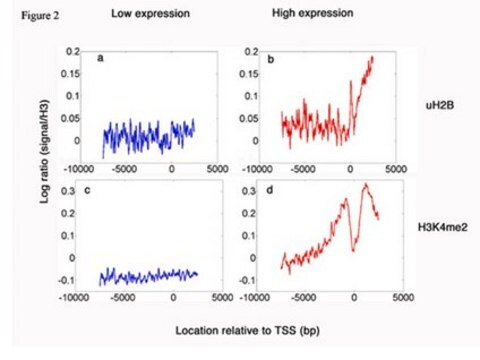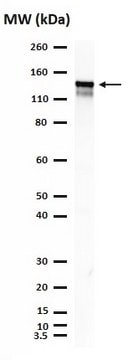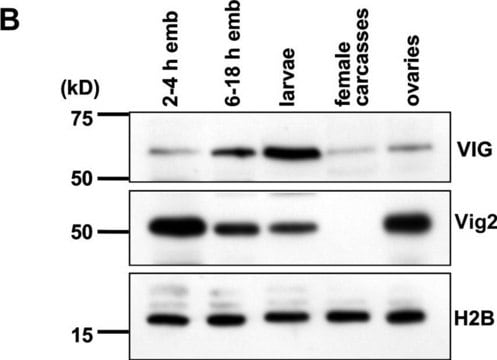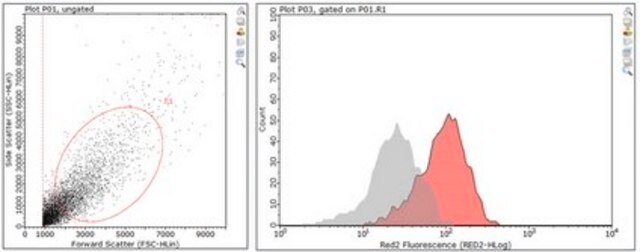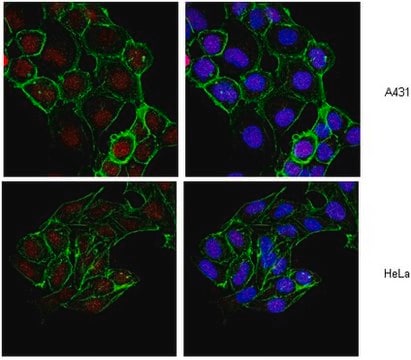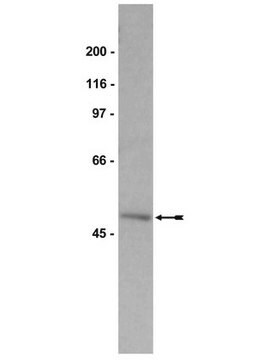17-650
ChIPAb+ Ubiquityl-Histone H2B - ChIP Validated Antibody and Primer Set
clone 56, from mouse, purified by using protein G
Synonym(e):
H2BUb, Histone H2B (ubiquityl), H2B histone family, member L, H2B.1 A, histone 1, H2bc, histone cluster 1, H2bc
About This Item
Empfohlene Produkte
Biologische Quelle
mouse
Qualitätsniveau
Klon
56, monoclonal
Aufgereinigt durch
using protein G
Speziesreaktivität
mouse, rat, vertebrates, human, plant
Hersteller/Markenname
ChIPAb+
Upstate®
Methode(n)
ChIP: suitable
immunofluorescence: suitable
immunoprecipitation (IP): suitable
western blot: suitable
Isotyp
IgG2aκ
NCBI-Hinterlegungsnummer
UniProt-Hinterlegungsnummer
Versandbedingung
dry ice
Allgemeine Beschreibung
The ChIPAb+ Ubiquityl-Histone H2B, (clone 56) set includes the Ubiquityl-Histone H2B, (clone 56) antibody, a negative control antibody (purified Mouse IgG), and qPCR primers which amplify a 213 bp region within the coding region of the human GAPDH gene.
The ubiquityl-Histone H2B and negative control antibodies are supplied in a scalable "per ChIP" reaction size and can be used to functionally validate the precipitation of Ubiquityl-Histone H2B associated chromatin.
Spezifität
Immunogen
Anwendung
Epigenetik & nukleäre Funktionen
Chromatin-Biologie (ChIP)
Histone
Sonicated chromatin prepared from HeLa S3 cells (1 X 106 cell equivalents per IP) was subjected to chromatin immunoprecipitation using 1 μg of either a normal mouse IgG or Anti-Ubiquityl-Histone H2B antibody and the Magna ChIP G Kit (Cat. # 17-611).
Successful immunoprecipitation of ubiquityl-Histone H2B associated DNA fragments was verified by qPCR using GAPDH promoter (negative) and GAPDH coding (positive) Primers (Please see figures). Data is presented as percent input of each IP sample relative to input chromatin for each amplicon and ChIP sample as indicated.
Please refer to the EZ-Magna G ChIP (Cat. # 17-409) or EZ-ChIP (Cat. # 17-371) protocol for experimental details.
Western Blot Analysis:
HeLa cell lysate was resolved by electrophoresis, transferred to PVDF and probed with anti-Ubiquityl-histone H2B at a dilution of 1:4000 (Please see figures).
Verpackung
Qualität
Sonicated chromatin prepared from HeLa S3 cells (1X 106 cell equivalents per IP) were subjected to chromatin immuno-precipitation using 1 µg of either a normal mouse IgG or Anti-ubiquityl-Histone H2B, clone 56 antibody and the Magna ChIP® G Kit (Cat. # 17-611). Successful immunoprecipitation of ubiquityl-Histone H2B-associated DNA fragments was verified by qPCR using Control Primers.
Please refer to the EZ-Magna ChIP G (Cat. # 17-409) or EZ-ChIP (Cat. # 17-371) protocol for experimental details.
Zielbeschreibung
Physikalische Form
Normal Mouse IgG. One vial containing 25 μg purified mouse IgG in 25 μL storage buffer containing 0.1% sodium azide. Store at -20°C.
ChIP Primers GAPDH Coding Region. One vial containing 75 μL of 5 μM of each primer specific for the coding region of human GAPDH. Store at -20°C.
FOR: GGC TCC CAC CTT TCT CAT CC
REV: GGC CAT CCA CAG TCT TCT GG
Lagerung und Haltbarkeit
Hinweis zur Analyse
Includes negative control mouse IgG antibody and primers specific for human GAPDH coding region.
Rechtliche Hinweise
Haftungsausschluss
Lagerklassenschlüssel
10 - Combustible liquids
Analysenzertifikate (COA)
Suchen Sie nach Analysenzertifikate (COA), indem Sie die Lot-/Chargennummer des Produkts eingeben. Lot- und Chargennummern sind auf dem Produktetikett hinter den Wörtern ‘Lot’ oder ‘Batch’ (Lot oder Charge) zu finden.
Besitzen Sie dieses Produkt bereits?
In der Dokumentenbibliothek finden Sie die Dokumentation zu den Produkten, die Sie kürzlich erworben haben.
Unser Team von Wissenschaftlern verfügt über Erfahrung in allen Forschungsbereichen einschließlich Life Science, Materialwissenschaften, chemischer Synthese, Chromatographie, Analytik und vielen mehr..
Setzen Sie sich mit dem technischen Dienst in Verbindung.